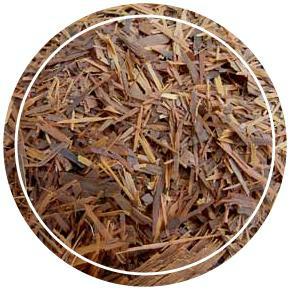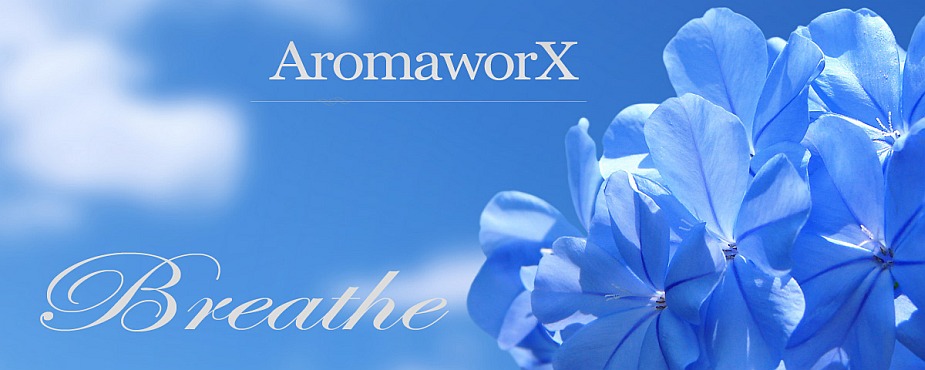Pau d'Arco
- Details
- Written by AndEl
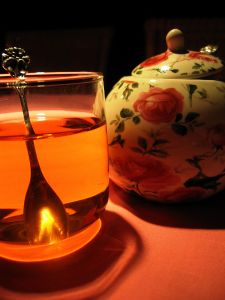
PAU D'ARC0 TEA - Medical experts throughout the world are now saying...
THERE IS A CURE FOR CANCER... FACT OR FICTION? Read on you'll be surprised!
Pau d'arco, an all natural anti-viral, anti-bacterial, anti-fungal agent, has been shown to be effective against candida, herpes, prostatitis, cancer, AIDS & more. At least one company has obtained a U.S. patent based on their research findings of a novel compound extracted from Tabebuia Avellanedae... commonly referred to as pau d'arco.
PAU D' ARCO is a natural grown herb that is derived from the inner bark of the Tabebuia Avellanedae or Tabebuia Impetiginosa (Taheebo) tree grown in South America. Pau d' Arco Tea has been used for many centuries by the Indio tribes of South America . The ancient Incas and Aztecs were probably the first to be familiar with the herbs healing powers. Stories abound telling of its miraculous curing powers.
Professor Walter Accorsi and Dr. Theodoro Meyer, the two modern discoverers of the healing power of Pau d'Arco, assess the herb to be the bearer of great medicinal powers. Doctors and healing specialists throughout the world now recommend Pau d'Arco tea for the treatment of many diseases.
DESCRIPTION
Lapacho
Botanical:Tabebuia Avellanedae,Tabebuia Impetiginosa
Family: Bignoniaceae
Synomyms: Taheebo. Ipê. Poui. Trumpet Tree. Pau d'Arco
Lapacho is an evergreen tree, with rosy colored flowers, belonging to the Bignonia family. Nearly 100 species of lapacho trees are known, but only a few of these yield high quality material, and it takes extremely skilled gatherers to tell the difference. (Half or more of the battle involved in bringing high quality lapacho to the marketplace is finding and retaining qualified gatherers.) The medicinal part of the tree is the bark, specifically the inner lining of the bark, called the phloem (pronounced floam). The use of whole bark, containing the dead wood, naturally dilutes the activity of the material. Lapacho is also known by the Portuguese name of Pau D'Arco, and by tribal names such as Taheebo and Ipê Roxo.
Some texts distinguish between Lapacho colorado (red lapacho-ipe roxo) (scarlet flowers) and Lapacho morado (purple lapacho) which grows in cooler climates such as high in the Andes, and high places in Paraguay. Recent evidence suggests that these two varieties of lapacho possess superior medicinal properties, with a slight bow going to the purple as the best of all.
CONSTITUENTS
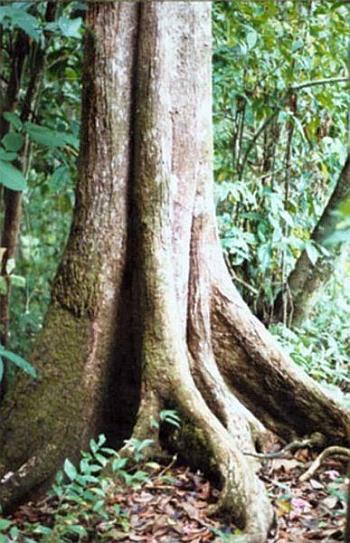 Most of the chemical analysis of lapacho have been performed on the heartwood of the tree, rather than on the phloem, or inner lining of the bark, which is used medicinally. It is unclear why this has occurred. One reason may be that the heartwood contains enough quantities of a couple of important constituents, mainly lapachol and tabebuin, to satisfy current research interests. Once the therapeutic activity of those constituents has been thoroughly investigated, perhaps researchers will turn their attention to the phloem. Until then, it is probably safe to assume that the living bark contains a similar set of active constituents as the heartwood plus some others that make it more effective and would account for the living bark's greater popularity as a folk medicine. Traditionally, as anyone who chooses to examine the herbal literature of the world can verify, it is the living bark of a plant, especially a tree or shrub, that is used medicinally - not the heartwood. The reason is simple: the nutrients and representative families of chemical substances used to sustain the life of the tree are found in greatest concentration in the cambium layer and phloem of the living bark.
Most of the chemical analysis of lapacho have been performed on the heartwood of the tree, rather than on the phloem, or inner lining of the bark, which is used medicinally. It is unclear why this has occurred. One reason may be that the heartwood contains enough quantities of a couple of important constituents, mainly lapachol and tabebuin, to satisfy current research interests. Once the therapeutic activity of those constituents has been thoroughly investigated, perhaps researchers will turn their attention to the phloem. Until then, it is probably safe to assume that the living bark contains a similar set of active constituents as the heartwood plus some others that make it more effective and would account for the living bark's greater popularity as a folk medicine. Traditionally, as anyone who chooses to examine the herbal literature of the world can verify, it is the living bark of a plant, especially a tree or shrub, that is used medicinally - not the heartwood. The reason is simple: the nutrients and representative families of chemical substances used to sustain the life of the tree are found in greatest concentration in the cambium layer and phloem of the living bark.
The life processes of a mature tree are carried out in the thin corridor lying between the outer bark and the inner heartwood. Pull the bark off a tree and you will notice moist, very thin layers of tissue that seem to shred when picked at with the hands. This is the cambium layer. Its purpose is to create new tree tissues, such as phloem, through cell division. The newest, youngest phloem cells are just outside the cambium. As new phloem is added, older cells are crushed and pressed into the bark. Younger, newer cells added to the inside of the cambium layer are called xylem. Newer xylem is called sapwood; older xylem is crushed and pressed into the heart of the tree. It is therfore known as heartwood. The actively conducting tissues of a tree are the thin layers of fresh xylem and phloem on each side of the cambium. The outer bark and heartwood are, essentially, inactive materials that only serve to provide strength to the tree. Indiscriminate combining of older, less active layers of bark and tree with the younger, living tissues results in a dramatic dilution of active principle and medicinal value. Yet it is a common practice.
Lapachol is just one of a number of plant substances known as napthaquinones (N-factors) that occur in lapacho. Anthraquinones, or A-factors, comprise another important class of compounds. The N-factors are not common except in herbal tonics. Seldom do both N- and A-factors occur in the same species. Several of the remarkable properties of lapacho may be due to a probable synergy between A- and N- factors.
Quercitin, xloidone and other flavonoids are also present in lapacho; these undoubtedly contribute to the plant's effectiveness in the treatment of tumors and infections.
FOLKLORE
The native Indians of Brazil, northern Argentina, Paraguay, Bolivia and other South American countries have used lapacho for medicinal purposes for thousands of years; there are indications that its use may actually ante-date the Incas. Before the advent of the Spanish, the Guarani and Tupi-Nambo tribes, in particular, used great quantities of lapacho tea. In the high Andes, the Callawaya, the Quechua, Aymara and other tribes used lapacho ("taheebo" to them) for many complaints.
Lapacho is applied externally and internally for the treatment of fevers, infections, colds, flu, syphilis, cancer, respiratory problems, skin ulcerations and boils, dysentery, gastro-intestinal problems of all kinds, debilitating conditions such as arthritis and prostatitis, and circulation disturbances. Other conditions have reportedly been cleared with lapacho including lupus, diabetes, Hodgkins disease, osteomyelitis, Parkinson's disease, and psoriasis.
It is used to relieve pain, kill germs, increase the flow of urine, and even as an antidote to poisons. Its use in many ways parallels that of the immuno-stimulants echinacea on this continent and ginseng in Asia, except that its action appears to exceed them both in terms of its potential as a cancer treatment. The Guarani, Tupi and other tribes called the lapacho tree "Tajy," meaning "to have strength and vigor," or simply, "The Divine Tree."
Modern Guarani Indians prefer the purple lapacho, but also use the red lapacho. And they use only the inner lining of the bark.
The use of lapacho may not be limited to tropical countries. A Yugoslavian scientist, Voislav Todorovic, claims that he has found evidence that the plant was used by the Vikings and the Russians. He also claims that a Russian chemist (in the late 1800's) manufactured a toothpaste that contained lapacho that was supposed to have been extremely effective in preventing tooth decay.
MODERN INVESTIGATIVE WORK
While scientific research on lapacho has been going on for decades, most of it is worthless from a medicinal point of view. Some of it, however, is very good, and has resulted in the isolation of several individual medicinally active constituents and in the analysis of their properties. The current interest in AIDS has stimulated renewed interest in lapacho since the herb is such an effective anti-viral substance.
The main problem with American research on the plant is the tunnel-vision with which the work is engaged. Without any understanding of the ultimate source of the plant's effectiveness, researchers routinely isolate what they think should be the active component and apply it in standard screening trials. The results of such research are sometimes positive, sometimes negative, sometimes strong, sometimes weak--always inadequate, by definition. It didn't surprise anyone that the trials performed by the National Cancer Institute were less than convincing. And it also didn't surprise anyone when that same institute rejected out-of-hand the highly positive results obtained by many non-American researchers who utilized different methods. The self-serving tendency of the American medical/regulatory establishment to accept only its own research is indulged by the rest of the world's scientific community with polite and somewhat amused patience, as they wait for America to grow up.
The following is a summary of some of the effects of lapacho and/or any of its constituents that have been validated by modern research:
Laxative effect. Regular use of lapacho will maintain regularity of bowel movements. This property is undoubtedly due to the presence of the napthaquinones and anthraquinones. Users of lapacho universally report a pleasant and moderate loosening of the bowels that leads to greater regularity without any unpleasant side-effects such as diarrhea.
Anti-cancer effect. The greater part of the basic research on lapacho, both in the United States and in other countries has dealt directly with the cancer question. Obviously, this issue is of great importance. Any tendency of lapacho to ameliorate the course of cancer should be made known to all persons likely to benefit from it. The absence of side effects makes lapacho a treatment of choice even in conjunction with standard forms of therapy. The user has nothing to lose and much to gain from the judicious use of lapacho. Naturally, any and all treatment of a cancerous condition should be done under the supervision of a qualified physician.
Some constituents or groups of constituents of lapacho have indeed been found to suppress tumor formation and reduce tumor viability, both in experimental animal trials and in clinical settings involving human patients. In addition, anecdotal data abounds to such an extent that to overlook its importance is to turn one's back on a potentially invaluable source of aid and health. Leukemia has proven particularly susceptible to the application of lapacho and several of its constituents. Some researchers feel that lapachol is one of the most important anti-tumor agents in the entire world.
Testimonial:
"I had a large tumor in my brain. Traditional treatment produced only minor success. Then I began to use lapacho tea. After several weeks a CAT scan showed that the tumor was totally gone. The doctors couldn't believe it because they had classified my case as basically untreatable."
Part of the effectiveness of lapacho may stem from its observed ability to stimulate the production of red blood cells in bone marrow. Increased red blood cell production would improve the oxygen-carrying capacity of the blood. This, in turn, could have important implications for the health of tissues throughout the body. Also needed for oxygen transport by red cells is iron. This might explain the augmentation in lapacho's therapeutic properties when it is combined with iron-rich yerbamate, another South American plant; in fact, it is native practice to almost always combine these two plant species.
Anti-oxidant effect. In vitro trials show definite inhibition of free radicals and inflammatory leukotrienes by lapacho constituents. This property might underlie the effectiveness of lapacho against skin cancer, and definitely helps to explain observed anti-aging effects. Modern science has recently uncovered the importance of free radicals in the generation of many debilitating diseases, from cancer to arthritis. These molecules are even heavily implicated in the normal aging process. Reversing their action has become big business in world health circles. Anti-oxidants, or free-radical scavengers, have emerged as premier candidates for the role of healers and disease-preventers. Among the antioxidants few have greater potency than lapacho and other constituents of lapacho.
Analgesic effect.The administration of lapacho is consistently credited in reports issuing from South American clinics as a primary modality for lessening the pain associated with several kinds of cancer, especially cancer of the prostate, liver or breast. Arthritic pain has also been relieved with lapacho ingestion.
Antimicrobial/anti-parisiticidal effects. Includes inhibition and destruction of gram positive and acid-fast bacteria (B. subtilis, M. pyogenes aureus, etc.), yeasts, fungi, viruses and several kinds of parasites. Two troublesome families of viruses inhibited by lapachol are noteworthy: Herpes viruses and HIV's. Together, these viruses account for much of the misery of mankind. The anti malarial activity of lapacho spawned a great deal of research interest in the early decades of this century. A 1948 article reviewed the progress and indicated that the N-factors, especially lapachol, were among the most promising anti malarial substances known at that time. Lapacho's immuno-stimulating action is due in part to its rather potent antimicrobial effects.
Testimonial:
"I began using yerbamate and lapacho tea about 3 mos. ago. I immediately experienced a surge of energy . . . within half-an-hour I was up dancing which is pretty amazing considering I've got MS and spent most of the Spring in a wheelchair. Within 2 days I noticed a lessening of pain and muscle spasms which was fantastic . . . my urinary, bowel and digestive functions have vastly improved . . . There is no doubt that the MS has greatly improved with the herbs as I quit using them for a week and all the old symptoms return. I start the tea again and they subside., I've repeated this scenario three times."
Anti-fungal effect. Lapacho is often singled out as the premier treatment for Candida or yeast infections. Lapachol, N-factors and xyloidone appear to be the primary active principles. By the mid 70's the list of N-factors that inhibited Candida albicans and other fungi had grown to several dozen.
It would be misleading to categorically state that the N-factors in lapacho have proven antimicrobial and anti fungal activity in and of themselves. Studies have shown that the manner in which they occur in the plant must be taken into consideration. We know, for example, that anti fungal activity is lost when the N-factors are tightly bound to highly water-soluble or highly fat-soluble groups. It has not been clearly determined how the N-factors occur in lapacho.
N-factors, obtainable from various chemical supply companies, have become favorite testing agents in government/university labs due to the rise in yeast infections resulting from increased use of cytotoxic drugs, corticosteroids, antibiotics and immuno-suppressants.
An interesting application has been reported in which toe and fingernail fungi infections are relieved by soaking these appendages in lapacho tea off and on for a couple of weeks.
Anti-inflammatory. The anti-inflammatory and healing action of lapacho extracts was demonstrated in a study in which purple lapacho extract was administered to patients with cervicitis and cervico-vaginitis, conditions resulting variously from infections (candida albicans, trichomonas vaginalis), chemical irritations and mechanical irritation. The lapacho extract was applied intra-vaginally via gauze tampons soaked in the extract, and renewed every 24 hours. The treatment proved to be highly effective. One wonders what might happen were the tampon method combined with the ingestion of strong teas.
The anti-inflammatory action of lapacho might also account for its observed tendency to reduce the pain, inflammation and other symptoms of arthritis. Anecdotal accounts of complete recovery are even available. As yet virtually untested in research settings, the purported ability of this plant to reduce symptoms of joint disease may be ultimately validated and added to the growing list of benefits to be enjoyed by the daily ingestion of lapacho tea.
Testimonial:
"I recently had a violent M.S. attack. I lost my balance, lost vision in my left eye and had excruciating pain in my left leg. I went to bed, took the anti-siezure medication and an analgesic. I drank about 1-1/2 quarts of lapacho and mate. Within 6 hours I was up stuffing turkey. Usually these episodes lay me up for weeks. I am convinced the lapacho and mate made the difference."
Other beneficial effects. Routine screenings have revealed several minor properties of lapacho that might occur if needed in certain individuals: diuretic, sedative, decongestant, and hypotensive, to name a few.
Testimonial:
"I started drinking the red lapacho because I had read a testimonial letter that indicated that its daily use had been effective against the pain of arthritis. I was skeptical to say the least. Prior to drinking the tea I could not stand on a hard surface for more than 5 minutes because the pain was excruciating in my hip . . . Since drinking the red lapacho regularly I have been on my feet for two or three hours without pain. Now the doctor tells me the tissues in my hip are regenerating!"
Anti-viral: One of the strongest actions of lapacho is against viruses. The range of viruses inactivated by lapacho extends from those that cause the common cold to those that are responsible for AIDS. It has been shown to actively inhibit, kill or stunt the growth of several dangerous viruses, including herpes virus hominis types I and II, polio virus, vesicular stomatitis virus, avian myeloblastosis virus, rauscho murine leukemia virus, friend virus, and rous sarcoma virus.
Several other viruses are also inhibited by lapacho's N- and A-factors.
One N-factor, beta-lapachone, inhibits enzymes in virus cells that directly affect the synthesis of DNA and RNA. It is also a potent inhibitor of the enzyme reverse transcriptase, involved in RNA/DNA relationships. Once these processes are inhibited, the virus is unable to take over the reproductive processes of the cell and cannot, therefore, replicate itself and infect other cells. Such inhibition is a characteristic of most substances that are being tested for activity against AIDS and Epstein-Barr.
The enzyme in question is a key to the action of retroviruses. These viruses, also known as ribodeoxyviruses or oncornaviruses, have been implicated in the development of several kinds of experimental cancers. Beta-lapachone is obtained simply by treating lapachol with sulfuric acid, and tests show that it has a unique method of action vis-a-vis the reverse transcpritase inhibition.
Testimonial:
"The yerbamate and red lapacho have made me feel more alert and awake, zesty, and happy, without the harmful side effects of caffeine; (they) increase virility and vigor."
Note: Sulfurous compounds in some plants, especially yerbamate, when combined with lapacho might provide a catalytic base for the transformation of lapachol tobeta-lapachone, and hence increase the effectiveness of the lapacho. In this light it is interesting to note that native folklore teaches that yerbamate is a catalyst for lapacho; yerbamate becomes the foundation for lapacho therapy.
Anti-Parasitic: Lapacho components have been intensively studied in terms of their action against two rather nasty parasites: Schistosoma mansoni andTrypanosoma cruzi, both responsible for considerable disease and misery in tropical countries. Lapacho was effective against both.
Taken by mouth, lapachol is eventually secreted onto the skin via the sebaceous glands where it acts as a topical barrier, inactivating microorganisms soon after they contact the skin. Meanwhile, throughout the G.I tract, it is performing the identical function on the mucous membranes, preventing the penetration of parasites. The mechanism of action is not well understood, but is felt to involve the uncoupling of cellular respiration, the stimulation of lipid peroxidation and super oxide production, and the inhibition of DNA/RNA biosynthesis.
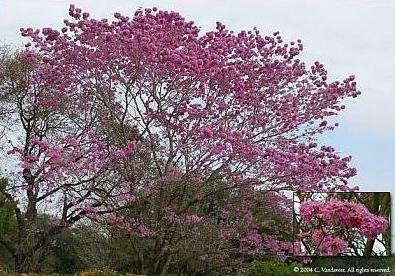
CANCER
Lapacho has been extensively investigated for potential anti-cancer activity. Even the National Cancer Institute has gotten in the act, but in their own typical way, they managed to drop the ball before achieving success. They restricted their investigations to lapachol, and once they found that this substance had side effects that offset its potential therapeutic benefits, they abandoned the project. The holistic practitioner readily perceives the fallacy of that approach, and is skeptical of applying isolated herbal constituents. As if in conformation of that skepticism, research that involved whole lapacho has produced clinical anti-cancer effects without side effects.
Animal research in the United States made a gigantic stride forward when it was discovered that lapachol inhibited solid tumors ( Walker carcinosarcoma 256 and Ehrlich solid carcinoma) and Ehrlich ascites cell tumors. Such research then took a gigantic stride backwards when clinical toxicity of lapachol prematurely ended these investigations.
One interesting line of research has shown that lapachol is more effective when ingested orally, rather than injected into the gut or into the muscles. These results contradict a substantial amount of research on orthodox drugs that indicates the superiority of injectable routes. What is the meaning of this anomaly? Could it be a sign that natural routes of administration (i.e., oral) are better suited for natural substances? The further removed from the natural state, the more active substances become when injected directly into the blood stream, and the less able the natural processes of the body are in dealing with them.
Using the wood of the plant, several researchers have studied the effects of lapachol, alpha- and beta-lapachone and xyloidone on experimental cancer (Yoshida's sarcoma and Walker 256 carcino-sarcoma). As high as 84% inhibition was observed on Yoshida's sarcoma. And no toxicity was found.
In one clinical study, South American researchers administered lapachol to patients with various forms of cancer, including adenocarcinoma of the liver, breast and prostate, and squamous carcinoma of the palate and uterine cervix. Taken orally, the substance resulted in temporary reduction of all conditions and in a significant reduction in pain.
Duration of treatment was anywhere from 30 to 720 days, with an average of about two months. For example, one patient with liver cancer presented with a significant reduction in jaundice accompanied by other signs of improvement after eight days of therapy. These results were in close accord with results obtained by the same researchers in animal studies. One wonders what the administration of whole purple lapacho phloem might have accomplished in this setting; other lines of evidence suggest that even better results may have been obtained.
Testimonial:
"During exploratory surgery it was noted that I had ovarian, stomach, intestine & liver cancer. I was told I had approximately 4 to 6 months to live. I made up my mind to fight. I went for chemotherapy, drank a quart of red lapacho tea, an ounce of aloe vera juice and took various vitamins daily. After 11 mos. the physicians could not believe what they found (no cancer). I continue to have regular check-ups and have proved to be a 'miracle case'."
A Note on Nausea: In the human study reported above, some patients dropped out of the experiment due to nausea. This is a common observation in some, but certainly not all, people who begin to experience the cleansing action of lapacho (and other healthful herbs). As toxins (and toxic medicines) and wastes are drawn out of the cells, or flushed out, or physiologically expelled from the cells, through the action of the herb, they tend at times to accumulate in the blood, lymph, lymph nodes, skin, liver and kidneys awaiting the opportunity to be expelled from the body.
Backing up, they can, on occasion produce sensations such as nausea; the body may even try to rid itself of some toxic substances by vomiting. Not to worry. These transient signs dissipate once the toxins are moving freely from the body. They are a positive sign that the herb is working. Remember the body only has three basic processes for getting rid of wastes: lower bowel movement, sweating, urinating. The use of lapacho can so overload these processes in the early stages that discomfort may be produced.
Testimonial:
"My wife was dying of cancer. She has a malignant tumor on her temple. The pain was so intense the doctors wanted to keep her sedated in the hospital until she died. We decided not to give up. For three weeks now she has been drinking purple lapacho tea. The tumor looks much better; it began draining and no longer looks so 'angry.' The pain is much less, and she can get up and move around the house. Our M.D. is impressed! . . . Now we have hope!"
Drug Detox Observations. A common thread that runs throughout early and current empirical and clinical reports of lapacho treatment is the consistent observation that the herb eliminates many of the common side effects of the orthodox medications. There is no explanation of this action, but it is so often seen that one cannot easily doubt its validity. Pain, hair loss and immune dysfunction are among the symptoms most commonly eliminated.
TOXICITY
While there can be no doubt that lapacho is very toxic to many kinds of cancer cells, viruses, bacteria, fungi, parasites and other kinds of microorganisms, the substance appears to be without any kind of significant toxicity to healthy human cells. The side-effects mainly encountered, and usually with isolated lapacho constituents, are limited to nausea and anticoagulant effects in very high doses, a tendency to loosen the bowels, and diarrhea in very high doses. As indicated earlier, some nausea should be expected as a natural consequence of the detoxification process. The FDA gave lapacho a clean bill of health in 1981.
Some trials have indicated that lapachol has anti-vitamin K action. Other constituents have a pro-vitamain K action; it is likely, therefore, that the two actions cancel each other out (except possibly when one or the other is necessary--as one would expect from an herbal tonic).
Perhaps the most significant study on toxicity was published in 1970 by researchers from the Chase Pfizer & Co., Inc.
Looking specifically at lapachol, these investigators found that all signs of lapachol toxicity in animals were completely reversible and even self limiting, i.e., over time the signs of toxicity decreased and even disappeared within the time constraints of the study. The most severe kinds of self-limiting side-effects they observed were an anti-vitamin K effect, anemia, and significant rises of metabolic and protein toxins in the blood stream. The diminution of these signs indicates that lapacho initiates an immediate "alterative" or "detoxification" effect on the body's cells. Once the cells are "cleaned up," the signs of toxicity disappear. This effect is quite common among herbal tonics.
HOW MUCH AND WHEN
Lapacho can be used periodically as a preventative during colds and flu season, or whenever the chances for infections are high. Experience has taught that lapacho is best ingested as a tea, one or two cups a day, morning and evening.
Directions: 3 Tablespoons of tea per quart of distilled or purified water... twice daily. For serious conditions, use 6-8 Tablespoons of tea per quart of distilled or purified water 3-4 times a day.
Used in this fashion, it promotes the health of the immune system, helps prevent the onset of colds and flus, keeps the bowel healthy and may impart some of the other important therapeutic effects, including a positive effect on arthritis, pain, localized infection (e.g. candida) and systemic infection.
During periods of acute, active infection, lapacho should be administered several times a day in tea form. It is up to the individual to determine the optimum amount for him or her. It is not uncommon for a person's awareness of his or her personal health needs and requirements to increase dramatically when turning to a health-oriented, herbal approach.
Testimonial:
"I was bitten by a brown recluse spider,but didn't know it for 3 days; it was finally diagnosed in an emergency room when the pain and swelling got so bad I couldn't take it any longer. An ointment was prescribed, but I used instead a compress made of two tea bags of lapacho, changed often. Relief was almost immediate. And, after 3 days, the doctor was amazed by the fact that all swelling and pain had disappeared, and new, healthy, tissue was growing back rapidly."
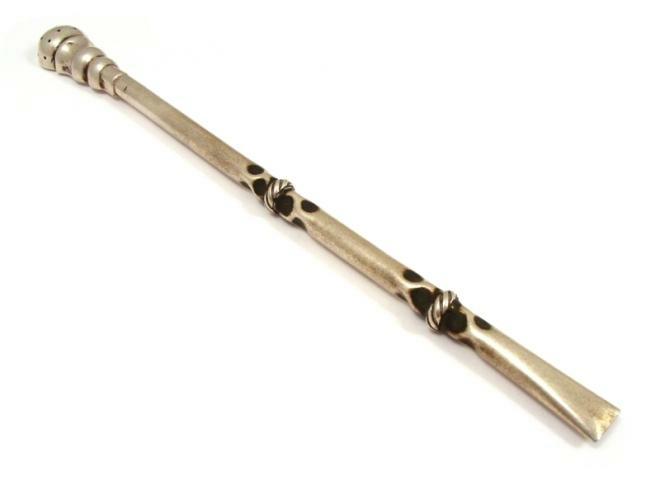 One of the best ways to ingest lapacho is in tea form, either with tea bags, or in a loosely cut and sifted, or "bulk" form. Using bulk presents problems of filtering out the fiber. The use of the South American "bombilla," a metal straw with a filter on one end, normally used for drinking yerbamate, neatly solves this problem.
One of the best ways to ingest lapacho is in tea form, either with tea bags, or in a loosely cut and sifted, or "bulk" form. Using bulk presents problems of filtering out the fiber. The use of the South American "bombilla," a metal straw with a filter on one end, normally used for drinking yerbamate, neatly solves this problem.
Capsules are also available, but are not nearly as effective as the tea. One of the most intriguing routes of administration is the recent introduction to the marketplace of a mist that is simply sprayed into the mouth and rapidly absorbed directly into the bloodstream.
It is highly recommended by this author as well as folklore wisdom that lapacho be routinely combined with yerbamate. The reasoning, based on centuries of experience in these matters by South American natives, is that the yerbamate has an activating effect on the actions of lapacho. Yerbamate, of course, imparts a good deal of medicinal action itself.
Into the Light
One of the last great, but largely untapped, reserves of natural resources on the face of the earth is South America. The herbal medicines that abound on this continent have been largely denied to the rest of the world; the inaccessibility of the great forests, combined with a general lack of interest, have kept the secrets of the region shrouded in darkness. Africa is a continent of light by contrast.
Efforts to increase the availability of South American herbal remedies have been extremely arduous and difficult. Only with great effort are we able to bring together all the resources necessary to successfully identify, harvest and export such plant materials. Much material coming into the U.S. from its southern neighbors has been falsely identified, or adulterated, or harvested incorrectly. Rare is the importer who even knows what to look for.
Nowhere have these difficulties been more apparent than in the marketing of lapacho. Lapacho (Tabebuia Avellandedae, & T. Impetiginosa) comes from the rain forests and mountains of Paraguay, Argentina and Brazil . We have known about this plant for almost 100 years, yet efforts to import medicinally active lapacho have failed more than they have succeeded. In spite of the difficulties, the interest remains extremely high, because this plant holds great promise for the effective treatment of cancers such as leukemia, candida and other troublesome infections, debilitating diseases (including arthritis), as well as a host of other complaints.
Anyone familiar with the recurring ginseng and goldenseal fiascos will appreciate the similar state of affairs that exists in the business of lapacho. In fact the chances of obtaining good quality ginseng and goldenseal in American health food stores are greater than the odds of obtaining good quality lapacho.
A vast majority of commercial lapacho is void of significant activity. The reason is primarily lack of quality control at every stage of the enterprise; gatherers, unaware as to which parts of the plant contain the active material, harvest all parts of the plant; curers, unaware of the traditional lapacho curing practices, make assumptions that are more often wrong than right; shippers pay little attention to protecting the material from the hazards of transportation; manufacturers, unaware of what constitutes really good lapacho (having never bothered to go to South America and have a look), don't have any idea how to set up quality control or standardization practices that guarantee activity.
You must exercise extraordinary care in your purchases of lapacho, and buy only when you have ascertained the expertise of the manufacturer. Generally speaking, the best lapacho will be obtained from manufacturers specializing in this herb.
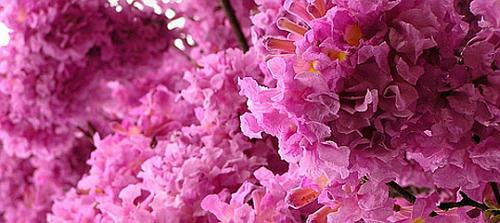
Lapacho - Buyer Beware
The old Roman phrase, caveat emptor - let the buyer beware, is applicable when buying Lapacho, Pau d'arco or Taheebo. As with many newly discovered helpful treatments, Lapacho is being marketed and used, often without appropriate background info. Unscrupulous suppliers have found it very profitable to grind up both the inner and worthless, bitter outer bark, and sometimes the entire tree, often without regard as to whether or not it was the correct Lapacho tree. This adulterated or even worthless material is shipped to unwary American packagers and is sold to the public as Pau d'arco, Taheebo, Ipê Roxo or Lapacho. Fortunately, there is also very high quality Lapacho in the U.S.
One clue to look for when shopping and comparing prices is to see if they recommend boiling the tea for at least 20 minutes. If they don't, chances are they are not very well informed either. I found this to be true with nearly every bulk importer that I encountered over the years.
ABOUT THE AUTHOR
Dr. Mowry is known primarily for his efforts to bring scientific data about herbal medicine to the attention of the American public. Toward this end he has published the books entitled the Scientific Validation of Herbal Medicine, and Guaranteed Potency Herbs: Next Generation Herbal Medicine, which have become standard texts in the field. Dr. Mowry is Director of the Mountainwest Institute of Herbal Sciences, in Salt Lake City, Utah .
Bibliography:
- "THE HEALING POWER OF PAUD' ARCO" By Walter Lubek, Lotus Light Publications
- "PAU D'ARCO - IMMUNE POWER from the Rain Forest" by Kenneth Jones, Healing Arts Press
- "NATURES WISDOM", Internet Article, 1998
- "PAU d"ARCO", Raintree Nutrition, Inc, Research Article, Leslie Taylor
- "ANCIENT HERB, MODERN MIRACLE" By Dr. D. Mowry, PhD, Mountainwest Institute of Herbal Sciences
- "SOUTH AMERICAN CANCER CURE", Alec de Montmorency, The Spotlight, June, 1981,
- "CANCER THERAPY" By Ralph Moss, PhD, Equinox Press
http://www.atlantishealthcenters.com/store/pau-d-arco-tea.htm
Liked this article? Dive deeper into personal growth and wellness! Check out CrystalWind.ca for spiritual wisdom or explore AromaWorx.ca for natural well-being tips. Spread the positivity—share this with friends on their happiness journey!
Let’s Chat! Drop Your Thoughts Below! ![]()
Disclaimer Health
All post and information provided within this blog is for educational and informational purposes only, and is not to be construed as medical advice or instruction. No action should be taken solely on the contents of this website. Please consult with your healthcare professional before making any dietary or lifestyle changes or taking supplements that may interfere with medications. Any products or information discussed are not intended to diagnose, prevent, treat or cure any illness, disease or lifestyle. Please consult your physician or a qualified health professional on any matters regarding your health and wellbeing or on any opinions expressed within this website.
Latest Articles

Imagine a world of inspiration and healing, free for all—made possible by YOU!
Donate Now—Ignite the Magic at CrystalWind.ca!

Epilepsy - Finding A Cure
Your donation can make a difference!
Help us find a cure – donate now!
Unlock Your Light: Join Lightworkers Worldwide on CrystalWind.ca!
Follow Us!
Featured This Month
Abalone Shell
Echos Of The Ancestors Abalone strengthens the structure of the body and th... Read more
Egyptian Zodiac/Astrology
Egyptian astrology was one of the earliest forms of astrology. The Egyptians w... Read more
Cancer Mythology
The Mythology of Cancer: A Celestial Tale of Loyalty and Sacrifice Among th... Read more
Chalcedony
The Stone Of Orators Chalcedony was very popular as a decorative stone in ant... Read more
Lugh - Celtic God Of The Sun
The god Lugh was worshiped in Ireland as a deity of the sun. This connection... Read more
Lammas by The Hedgewitch
Although in the heat of a Mid-western summer it might be difficult to discer... Read more
Sun in Cancer
Cancer Sun Sign Characteristics Overview The name "Cancer" comes from Latin, ... Read more

